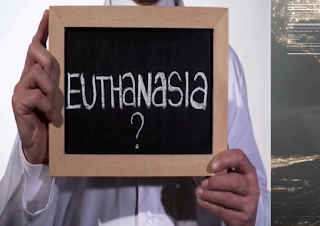In simple terms, If a person wants to die then he can die on the basis of his choice. People wants to die for various reasons. But death is not the solution for any problem. On the other hand, Some wants to die due to the incurable disease that he is suffering from. Such peoples should also have the right to die with dignity. In India, Euthanasia have been a debatable topic for a long time but on 9 March 2018 the honourable Supreme Court of India has allowed passive euthanasia in India. Euthanasia is allowed in some religions also. Like in Jainism, A person is allowed to take 'Santhara' in last days of his life. It is the religious practice of voluntarily fasting to death by gradually reducing the intake of food and liquids. In Jainism, it is not considered as a suicide. Instead they call it "Death with dignity."
Euthanasia is allowed in some of the countries also. In America, Euthanasia is not allowed but in some of the provinces like Washington DC, California & Colorado 'Assisted Suicide' is allowed.
'Assisted Suicide 'is allowed in Switzerland & Germany as well. In Netherlands, after having a discussion for 30 years and in Belgium for 3 years, Euthanasia was allowed in the year 2001 and 2002 respectively.
Types of Euthanasia
- Passive Euthanasia: If anyone who is in permanent vegetative state like in coma wants to die then to whom ever he has designated in his 'living will' will take decision behalf of him. If the designated person allows to give him passive euthanasia then all the life supporting system will be removed and medications will be stopped. The person will die gradually. India joins the countries that allows Passive Euthanasia. (Living Will : A will in which a person decides in advance to refuse life support system in case of terminal illness. In this will, he designates a person who will take decision on his behalf)
- Active Euthanasia: It involves administering a lethal dose on a terminally ill person. It is illegal in India and considered as a criminal offence as it can be misused to take one's life.
- Assisted Suicide: A type of euthanasia where doctors can write those medicines after whose consumption the patient dies. It is allowed in few countries mentioned above.
Aruna Shanbaug v/s Union of India Case
Aruna Shanbaug's case relates to passive euthanasia. She was sexually assaulted (She was about to marry in a month) in a hospital in Mumbai in 1973. After this incident, she becomes comatose and remains in persistent vegetative state for 42 years. In 2011, a petition was filed on The Supreme Court of India but the court rejected the petition. Aruna Shanbaug died in 2015. Passive Euthanasia then becomes legal in India but only in a special circumstances.
Arguments
Long years ago The Supreme Court said that Right to Life means 'A dignified life' and if the state can not improve the daily livelihood of people or if the state fails in fulfilling the basic needs of people then state has no right to prevent anyone to die. We got the 'Right to life and Personal Liberty' under article 21 of the Indian Constitution so 'Right to Die with Dignity' should also be there. Comatose person and the person who is suffering from incurable diseases cannot be allowed to continue suffering. Is it a justice with them to keep them on life supporting system forcefully? They can't even express their feelings. To consider this, The Supreme Court of India confirms that Right to Die with Dignity is a Fundamental Right. As the court allows passive euthanasia, strict guidelines have been made by the court to prevent the misuse of it.
Let's consider the another side of it.
Every person is associated with another person. If a person dies it affects the lives of many people. If a person is allowed for euthanasia then who will look after his family? What if he is the sole bread winner of their his family? Life of a person is life of a family also.
Let's consider the another side of it.
Every person is associated with another person. If a person dies it affects the lives of many people. If a person is allowed for euthanasia then who will look after his family? What if he is the sole bread winner of their his family? Life of a person is life of a family also.
Always remember that euthanasia is only for those who actually need it. And ending the life is never a solution.


Good .. . .👍👍
ReplyDeleteThanks !
DeleteNice
ReplyDelete